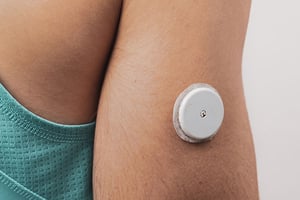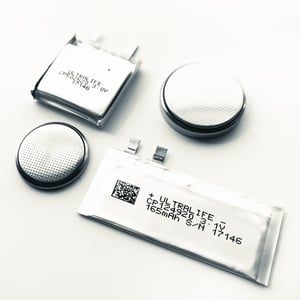Ultralife manufacture Thin Cells® for CGM sensors and rechargeable batteries for handheld receivers, plus Thin Cells® can be used in insulin pump patches
Celebrity Big Brother runner-up Nikita Kuzmin made headlines when some viewers believed he had smuggled a phone into the diary room of the reality TV show's house. However, the phone-like device he had on his lap and the white patch viewers spotted on his arm were portable medical devices that he used to control his type 1 diabetes.
Both are battery-powered, so battery manufacturer Accutronics Ltd (an Ultralife company) looks at the types of batteries that keep these devices running, plus the new trend to manage diabetes using battery-powered insulin pump patches.
The NHS defines type 1 diabetes as when your body cannot produce enough of a hormone called insulin, which controls blood glucose. People who have type 1 must take insulin daily to control their blood glucose levels, as otherwise hypoglycaemia (also called a hypo) can happen when the blood glucose level is too low.
Continuous Glucose Monitor (CGM) Batteries
 The white patch on Nikita’s arm was a continuous glucose monitor (CGM) that he used to estimate his glucose level every few minutes. It contained a tiny sensor that was inserted under the skin and a sticky patch helped it to remain in place. Each time the sensor collected the glucose level, the data was transmitted to a receiver, which is what some viewers mistook for a phone. CGM sensors can actually transmit glucose levels to software on smartphones but having a separate device is useful for situations where phones are not allowed, such as in schools or on a television programme like Celebrity Big Brother, or for the 13% of UK adults that do not own a smartphone.
The white patch on Nikita’s arm was a continuous glucose monitor (CGM) that he used to estimate his glucose level every few minutes. It contained a tiny sensor that was inserted under the skin and a sticky patch helped it to remain in place. Each time the sensor collected the glucose level, the data was transmitted to a receiver, which is what some viewers mistook for a phone. CGM sensors can actually transmit glucose levels to software on smartphones but having a separate device is useful for situations where phones are not allowed, such as in schools or on a television programme like Celebrity Big Brother, or for the 13% of UK adults that do not own a smartphone.
Because a CGM sensor is inserted into the body, it can only last for around 7 to 14 days (device dependent) before it must be disposed of. Therefore, they are usually sold with a non-rechargeable battery embedded, which is also the best option for keeping the devices small due to their high energy density (the amount of energy compared to the volume or weight). The smaller the CGM, the less it will protrude and the lower the risk of it getting caught on clothing when the wearer (in this case Nikita) gets dressed.
However, the amount of energy density varies from one battery to another. Ultralife manufacture Thin Cells® that have an energy density of around 500Wh/l and 400Wh/Kg compared to just 300Wh/l and 260Wh/kg for the best lithium coin cells. Thin Cells® can also be made in custom sizes to fit the available space inside the CGM.
Every few minutes, when the device is transmitting the glucose level to the receiver, high bursts of energy are needed to power RF transmitters. The use of low resistance current collectors allows Ultralife Thin Cells® to outperform coin cells in these applications.
Handheld Glucose Monitor Batteries
The receiver that can get mistaken for a smartphone also contains a battery. Although, as this device is not going inside the body, it does not need to be disposed of and can use a rechargeable battery. These readers can measure about the size of a credit card, so Accutronics Ltd (a battery manufacturer based in the UK) manufacture 3.7V batteries to these dimensions. Shrink-wrapped packs in various sizes are also available or a custom battery can be developed to meet the specific size, weight, and power requirements.
Insulin Pump Patch Batteries
As well as the devices Nikita used, there is a new trend to manage diabetes with disposable insulin pump patches that attach to the arm. These patches use electronics to run the pump that typically have greater power needs than monitoring devices. In devices where high power is needed, Ultralife Thin Cells® have a continuous discharge current up to ten times that of a coin cell of the same capacity. Insulin pump patches are generally smaller than CGMs, so the higher energy density of Thin Cells® versus coin cells makes them favourable.
Programmes like Celebrity Big Brother are invaluable in raising awareness of the battery-powered devices that are used to manage diabetes. With advancements in medical technology happening all the time, who knows what devices we will see in television programmes twenty years from now.



